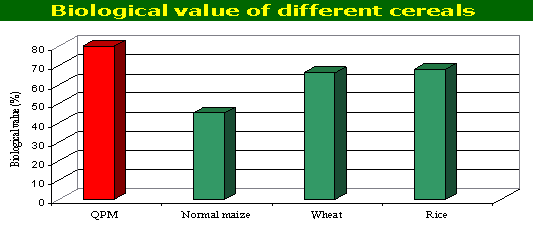देश के भोजन और पोषण संबंधी सुरक्षा के लिए गुणवत्ता प्रोटीन मक्का के एकल क्रॉस संकर।
Maize is an important coarse grain cereal crop of India accounting for ca 8.5% to the food basket (Anonymous, 2010). With its high carbohydrates, fats, proteins, some of vitamins and minerals, it is nutritious for human consumption, and is hence termed as nutricereal. Maize grain is also used as an important ingredient of feed for cattle, poultry, pig or fish meals.
The maize grain on an average, contains 14.9 % moisture, 11.1 % protein, 3.6 % fat, 2.7 % fibre, 66.2 % other carbohydrates and 1.5% minerals (National Institute of Nutrition, 2002). The kernel protein is made up of five different fractions, viz. albumin 7 %, globulin 5 %, non-protein nitrogen 6 %, prolamine 52 % and glutelin 25 % and the left over 5 % is residual nitrogen. The protein quality is considered poor due to the presence of large concentrations of an alcohol soluble protein fraction called "prolamine" also known as 'Zein' in the endosperm. Zein , deficient in two essential amino acids, viz lysine and tryptophan, contributes 50 - 70 % of the total protein, due to this obvious reason the protein of maize grain is low in lysine and tryptophan. On the other hand, zein fractions contain very high amount of leucine along with imbalanced proportion of isoleucine.
The high quality of protein in other fractions in other parts of maize kernel becomes ineffective due to the pre-dominance of zein in maize. This results in the over -all poor quality of maize protein which affects its 'Biological value' i.e. the availability of protein in the body. Therefore, a need was felt to improve biological value of maize varieties. This has been corrected through the development of specialized maize called "Quality Protein Maize" (QPM) hybrids with better-balanced amino acid composition including the presence of high amount of lysine and tryptophan and low amount of leucine.The biological value of normal maize protein is just half as compared to that of Quality Protein Maize (Fig 1).
Hence, replacement of common maize by QPM is most effective and attractive measure to meet quality protein needs and raise the human nutritional status. Over a period of seven years of active research, India has developed an expertise in this area and consequently as many as eight single cross hybrids have been released. The details of these hybrids are given in the Table1.
QPM can be utilized for diversified purposes in food and nutritional security as infant food, health food/mixes, convenience foods, specialty foods and emergency ration. It is also useful in fulfilling the protein requirements of different sections of society ,viz. infants, lactating mothers' convalescing patients, Kwashiorkor diseased, old persons and infirm, etc. to prevent malnutrition.
Its green cob is very nutritious, tasty and liked by people. Deployment of QPM single cross hybrids would contribute to food and nutritional security to the country especially to the poor and tribal farmers, where maize is consumed as staple food. Thus there is an urgent need to popularize QPM among our population especially the malnourished segments of the society.
The products developed from QPM can replace fancied and highly priced industrial foods. These can also be prepared in villages and thus could be a great source of rural entrepreneurship.
Fig.1: Biological value of Quality Protein Maize vis a vis other cereals

Table 1: QPM single cross hybrids released in India
| Single cross Hybrid | Average yield (qtls/ha)* | Maturity (days)** | Protein content(%) | Tryptophan content in Protein (%) | Grain colour | Area of adaptation |
| HQPM4 | 67 | 90 | 9.0 | 0.07 | Yellow | Across the country |
| HQPM-7 | 65 | 90 | 9.8 | 0.072 | Yellow | Peninsular India |
| Vivek QPM-9 | 45 | 75 | 9.2 | 0.070 | Yellow | Himalayan belt |
| HQPM-5 | 65 | 88-90 | 10.15 | 0.069 | Light- orange | Across the country |
| HQPM-1 | 60 | 88-90 | 10.09 | 0.079 | Yellow | Across the country |
| Shaktiman-4 | 60 | 95 | 10.29 | 0.072 | Orange- yellow | Bihar |
| Shaktiman-3 | 60 | 95 | 8.86 | 0.061 | Orange- yellow | Bihar |
| Shaktiman-2 | 60 | 95 | 9.27 | 0.070 | White | Bihar |
*Yield during Kharif season, **During Kharif season
Authors:
J. Kaul, Sain Dass and R. Sai kumar
Directorate of Maize research, Pusa Campus, New Delhi 110 012
Email:
